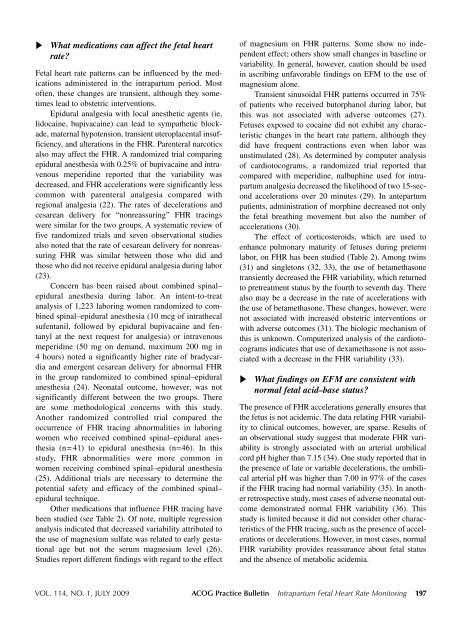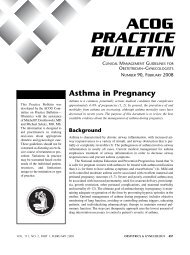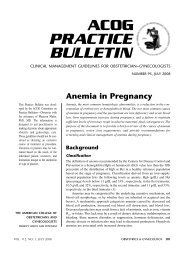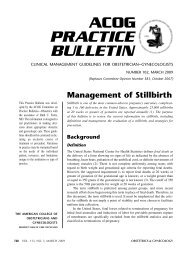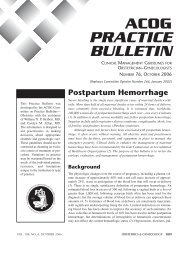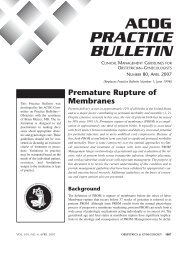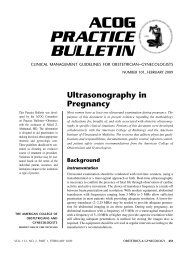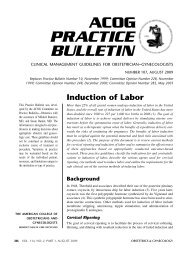ACOG Practice Bulletin: Intrapartum Fetal Heart rate Monitoring
ACOG Practice Bulletin: Intrapartum Fetal Heart rate Monitoring
ACOG Practice Bulletin: Intrapartum Fetal Heart rate Monitoring
- No tags were found...
You also want an ePaper? Increase the reach of your titles
YUMPU automatically turns print PDFs into web optimized ePapers that Google loves.
What medications can affect the fetal heart<strong>rate</strong>?<strong>Fetal</strong> heart <strong>rate</strong> patterns can be influenced by the medicationsadministered in the intrapartum period. Mostoften, these changes are transient, although they sometimeslead to obstetric interventions.Epidural analgesia with local anesthetic agents (ie,lidocaine, bupivacaine) can lead to sympathetic blockade,maternal hypotension, transient uteroplacental insufficiency,and alterations in the FHR. Parenteral narcoticsalso may affect the FHR. A randomized trial comparingepidural anesthesia with 0.25% of bupivacaine and intravenousmeperidine reported that the variability wasdecreased, and FHR accelerations were significantly lesscommon with parenteral analgesia compared withregional analgesia (22). The <strong>rate</strong>s of decelerations andcesarean delivery for “nonreassuring” FHR tracingswere similar for the two groups. A systematic review offive randomized trials and seven observational studiesalso noted that the <strong>rate</strong> of cesarean delivery for nonreassuringFHR was similar between those who did andthose who did not receive epidural analgesia during labor(23).Concern has been raised about combined spinal–epidural anesthesia during labor. An intent-to-treatanalysis of 1,223 laboring women randomized to combinedspinal–epidural anesthesia (10 mcg of intrathecalsufentanil, followed by epidural bupivacaine and fentanylat the next request for analgesia) or intravenousmeperidine (50 mg on demand, maximum 200 mg in4 hours) noted a significantly higher <strong>rate</strong> of bradycardiaand emergent cesarean delivery for abnormal FHRin the group randomized to combined spinal–epiduralanesthesia (24). Neonatal outcome, however, was notsignificantly different between the two groups. Thereare some methodological concerns with this study.Another randomized controlled trial compared theoccurrence of FHR tracing abnormalities in laboringwomen who received combined spinal–epidural anesthesia(n= 41) to epidural anesthesia (n=46). In thisstudy, FHR abnormalities were more common inwomen receiving combined spinal–epidural anesthesia(25). Additional trials are necessary to determine thepotential safety and efficacy of the combined spinal–epidural technique.Other medications that influence FHR tracing havebeen studied (see Table 2). Of note, multiple regressionanalysis indicated that decreased variability attributed tothe use of magnesium sulfate was related to early gestationalage but not the serum magnesium level (26).Studies report different findings with regard to the effectof magnesium on FHR patterns. Some show no independenteffect; others show small changes in baseline orvariability. In general, however, caution should be usedin ascribing unfavorable findings on EFM to the use ofmagnesium alone.Transient sinusoidal FHR patterns occurred in 75%of patients who received butorphanol during labor, butthis was not associated with adverse outcomes (27).Fetuses exposed to cocaine did not exhibit any characteristicchanges in the heart <strong>rate</strong> pattern, although theydid have frequent contractions even when labor wasunstimulated (28). As determined by computer analysisof cardiotocograms, a randomized trial reported thatcompared with meperidine, nalbuphine used for intrapartumanalgesia decreased the likelihood of two 15-secondaccelerations over 20 minutes (29). In antepartumpatients, administration of morphine decreased not onlythe fetal breathing movement but also the number ofaccelerations (30).The effect of corticosteroids, which are used toenhance pulmonary maturity of fetuses during pretermlabor, on FHR has been studied (Table 2). Among twins(31) and singletons (32, 33), the use of betamethasonetransiently decreased the FHR variability, which returnedto pretreatment status by the fourth to seventh day. Therealso may be a decrease in the <strong>rate</strong> of accelerations withthe use of betamethasone. These changes, however, werenot associated with increased obstetric interventions orwith adverse outcomes (31). The biologic mechanism ofthis is unknown. Computerized analysis of the cardiotocogramsindicates that use of dexamethasone is not associatedwith a decrease in the FHR variability (33).What findings on EFM are consistent withnormal fetal acid–base status?The presence of FHR accelerations generally ensures thatthe fetus is not acidemic. The data relating FHR variabilityto clinical outcomes, however, are sparse. Results ofan observational study suggest that mode<strong>rate</strong> FHR variabilityis strongly associated with an arterial umbilicalcord pH higher than 7.15 (34). One study reported that inthe presence of late or variable decelerations, the umbilicalarterial pH was higher than 7.00 in 97% of the casesif the FHR tracing had normal variability (35). In anotherretrospective study, most cases of adverse neonatal outcomedemonst<strong>rate</strong>d normal FHR variability (36). Thisstudy is limited because it did not consider other characteristicsof the FHR tracing, such as the presence of accelerationsor decelerations. However, in most cases, normalFHR variability provides reassurance about fetal statusand the absence of metabolic acidemia.VOL. 114, NO. 1, JULY 2009 <strong>ACOG</strong> <strong>Practice</strong> <strong>Bulletin</strong> <strong>Intrapartum</strong> <strong>Fetal</strong> <strong>Heart</strong> Rate <strong>Monitoring</strong> 197


